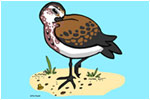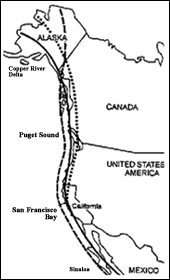| |
|
Chapter 1: Maya on a Mexican Shores
Hi! Hola!
My name is Maya. I am a Western Sandpiper and just a little under one year old. I am basking in the warm Mexican sun and listening to the waves crash on the beach in the distance. I am on the edge of an estuary. While it is a beautiful day with a warm breeze at my back, I am nervously considering what migration means. What is migration? As far as I can tell, it is scary because it means a very long journey without many stops. My family flies this marathon two times a year with a few short stops along the way to rest and eat. That's like driving thousands of miles in a car with fewer than five rest stops! We travel north up the Pacific coast to our breeding grounds in Alaska. At the end of the summer in Alaska, we migrate south back to Mexico. "It's … well… like endless summer!"
I was born in an Alaskan wetland and flew all the way down to Mexico at the end of last summer. But that was many months ago and I was so young then. I barely remember the trip. The amazing part about the journey is the fact that shorebird parents leave their fledgling babies ["yep, like me!"] behind to find their way south all by themselves! I can't believe I really did that! Somehow, the stars and some kind of internal compass guide us all the way to our final destination. The fact that we can do this all alone is an incredible mystery--even to scientists, who are still trying to figure it out. And then upon our arrival in Mexico, we reunite with our families.
Since I don't remember my first migration very well, I am told that when I arrived in Mexico, I was exhausted and so, so very happy to see everyone again. Jorge, my brother, and Abulito, my grandfather, showed me how to quickly regain my energy by eating nutrient-rich food and getting the rest I needed. Once I recovered, I soon met Oxy and Maria, who are now my two best friends. They are young Western Sandpipers, too, and they will soon join my family and me as we embark on my first migration north from Mexico. It can be confusing: we live in Mexico in the winter and in Alaska in the summer. Humans call my winter home in Mexico
"wintering grounds."
 Historically, I'm told, my family makes four stops along the Pacific Coast. [Click the map to enlarge and to find the wintering, staging, and breeding areas we will visit.]
Historically, I'm told, my family makes four stops along the Pacific Coast. [Click the map to enlarge and to find the wintering, staging, and breeding areas we will visit.]
Our journey will take us to the Alaskan tundra where I will find a mate and breed. Such a long journey makes me very nervous. We start off from here, Sinaloa, Mexico, and make our first stop in Southern California. After this stopover, called a "staging area", we stop in other wetlands along the West Coast like the Copper River Delta, my brother Jorge's favorite place in the world. Jorge tell us that there's a huge variety of clams and worms as well as many different kinds of shorebirds to meet here, in the Mexican State of Sinaloa, and make.
  |
|
|
|
